
![]() Describe what you believe is the world’s most important invention and why.
Describe what you believe is the world’s most important invention and why.
Click here to download a PDF of the SSAT Practice Test.
Time - 25 Minutes
1 Topic
Writing Sample
Schools would like to get to know you better through a story you will tell using one of the ideas below. Please choose the idea you find most interesting and write a story using the idea in your first sentence. Please fill in the circle next to the one you choose.

![]() Describe what you believe is the world’s most important invention and why.
Describe what you believe is the world’s most important invention and why.

![]() If only I could reach the water’s edge.
If only I could reach the water’s edge.
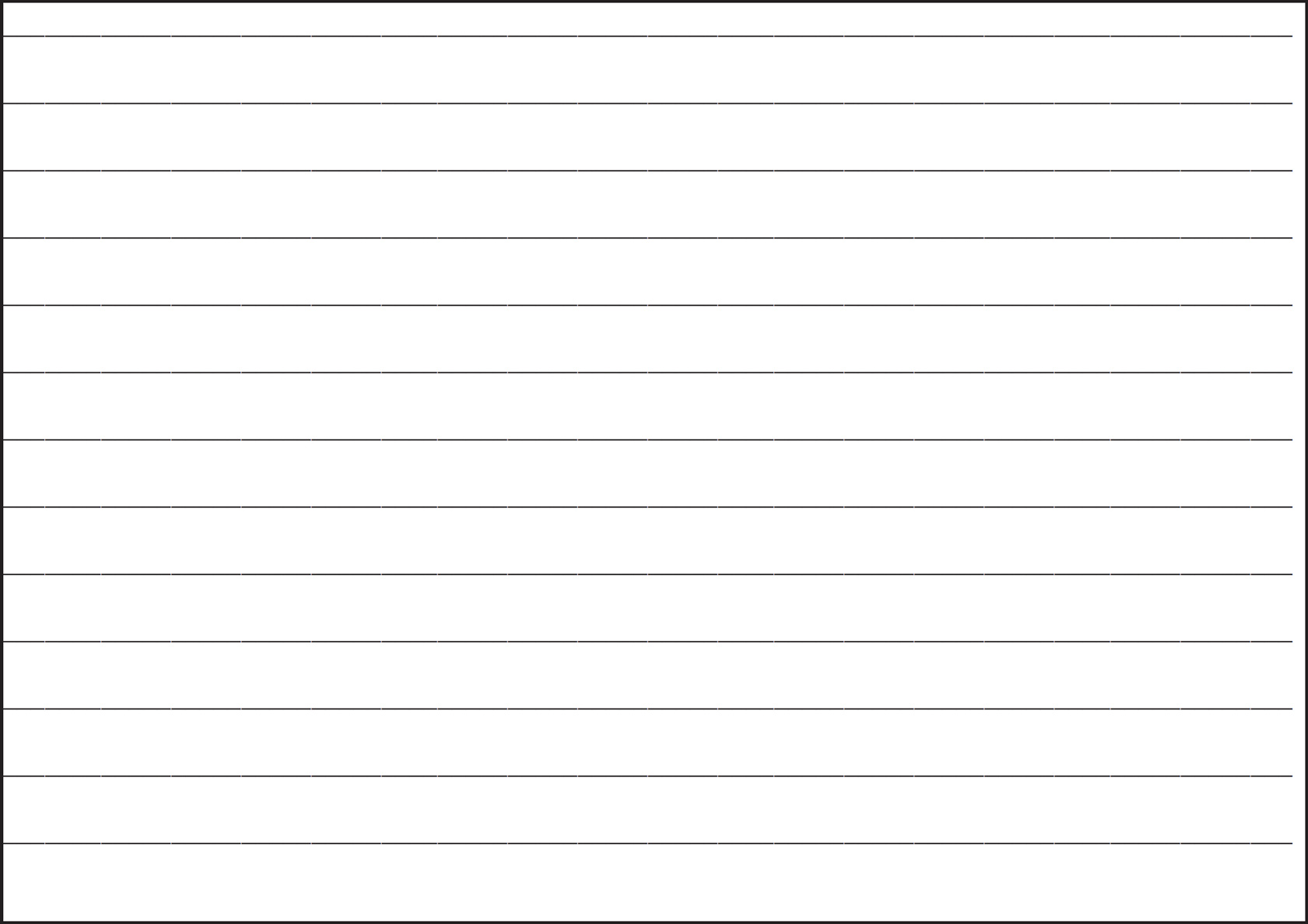

Time - 30 Minutes
25 Questions
Following each problem in this section, there are five suggested answers. Work each problem in your head or in the blank space provided at the right of the page. Then look at the five suggested answers and decide which one is best.
Note: Figures that accompany problems in this section are drawn as accurately as possible EXCEPT when it is stated in a specific problem that its figure is not drawn to scale.
Sample Problem:

(A) 586
(B) 596
(C) 696
(D) 1,586
(E) 1,686

1. If 12 × B = 24, then 24 – B =
(A) 0
(B) 
![]()
(C) 2
(D) 12
(E) 22
2. When 7,497 is divided by 198, the result is closest to which one of the following?
(A) 25
(B) 30
(C) 40
(D) 45
(E) 450
3. Based on the figure provided, approximately how much snow accumulated during the 7 hours?
| Hour | inches of snow |
| 1 | 2.3 |
| 2 | 3.5 |
| 3 | 5.4 |
| 4 | 6.0 |
| 5 | 3.9 |
| 6 | 1.2 |
| 7 | 0.8 |
(A) 6 in
(B) 11 in
(C) 20 in
(D) 23 in
(E) 24 in
4. 0.025 × 30 =
(A) 0.0075
(B) 0.075
(C) 0.075
(D) 0.75
(E) 7.5
5. If Z > 3, then 5Z + 7 could be
(A) 19
(B) 20
(C) 21
(D) 22
(E) 23
6. 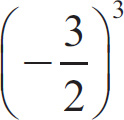
 =
=
(A) 
![]()
(B) 
![]()
(C) −
![]()
(D) −
![]()
(E) −
![]()
7. A large square box is made up of smaller square boxes. Each of these smaller boxes has a side length of 4 inches. How many of these smaller boxes are used to create the larger box if the larger box’s base has a perimeter of 32 inches?
(A) 4
(B) 8
(C) 16
(D) 64
(E) 124
8. Evaluate: (–15) + (–19) + 39
(A) –73
(B) –5
(C) 0
(D) 5
(E) 73
9. What is the value of the greatest of four consecutive integers is the greatest is three less than one-third of the least?
(A) –9
(B) –6
(C) 0
(D) 6
(E) 9
10. The perimeter of a hexagon is 42 units. If the length of each side is reduced by 3 units, what is the perimeter of the new figure?
(A) 20
(B) 24
(C) 30
(D) 36
(E) 39
Questions 11 and 12 are based on the accompanying graph.


11. What fraction of the people chose Documentary?
(A) 
![]()
(B) 
![]()
(C) 
![]()
(D) 
![]()
(E) 
![]()
12. The number of people who chose Romance is what percent of the number of people who chose Thriller?
(A) 25%
(B) 50%
(C) 67%
(D) 75%
(E) 90%
13. A particular entrance is 84 inches tall. Kyle is planning a costume party and wants to enter the room through this doorway. If Kyle is 1.5 meters tall, the tallest hat he can place on his head and still be able to walk through the doorway without his hat touching the frame of the entrance must be less than which of the following? (1 m = 39 in)
(A) 24 in
(B) 25 in
(C) 25.5 in
(D) 39 in
(E) 58.5 in
14. Carol works 60 yards from the coffee shop, and Mike works 80 yards from the same coffee shop. What is the distance, in yards, from Carol’s place of work to Mike’s place of work?
(A) 10 yards
(B) 20 yards
(C) 100 yards
(D) 140 yards
(E) It cannot be determined from the information given.
15. 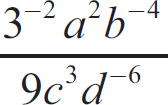
 =
=
(A) 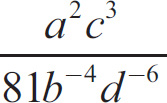

(B) 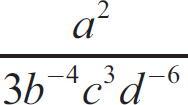

(C) 

(D) 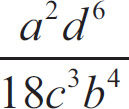

(E) 
![]()
16. 
![]() =
=
(A) 
![]()
(B) 
![]()
(C) 
![]() + 5
+ 5
(D) 
![]()
(E) 
![]()
17. For a certain number, 40% of that number is 240. What is 60% of that number?
(A) 60
(B) 100
(C) 260
(D) 360
(E) 2,400
18. The length of a rectangle is four times its width. If the perimeter of the rectangle is 50, what is the area of the rectangle?
(A) 5
(B) 10
(C) 20
(D) 50
(E) 100


19. In the figure, P is the center of the circle, and triangle QPR is a right triangle with vertices Q and P on the circle. If the circumference of the circle is 12π, what is the area of the shaded region?
(A) 36 – 18π
(B) 18π – 36
(C) 9π – 18
(D) 18 – 9π
(E) It cannot be determined from the information given.
20. Which of the following gives the value, in cents, of a dimes, b quarters, and 6 pennies?
(A) 
![]() + 1
+ 1
(B) 
![]() + 6
+ 6
(C) 10a + 10b + 6
(D) 10a + 25b + 1
(E) 10a + 25b + 6
21. If 70% of 3k is 12, what is 35% of 6k?
(A) 2
(B) 6
(C) 12
(D) 24
(E) 28
23. A survey found that each of 400 people has a smart phone, a tablet, or both. If 350 of these people have smart phones, and 150 have tablets, how many people have both a smart phone and a tablet?
(A) 50
(B) 100
(C) 150
(D) 200
(E) 250
24. If y is an integer greater than 1, which of the following is greatest?
(A) y + 2
(B) 2y + 2
(C) 2y – 2
(D) y + 
![]()
(E) 

25. What is the sum of the exterior angles of an equilateral triangle?
(A) 60°
(B) 90°
(C) 120°
(D) 240°
(E) 360°
STOP
IF YOU FINISH BEFORE TIME IS CALLED,
YOU MAY CHECK YOUR WORK ON THIS SECTION ONLY.
DO NOT TURN TO ANY OTHER SECTION IN THE TEST.
Time - 40 Minutes
40 Questions
Read each passage carefully and then answer the questions about it. For each question, decide on the basis of the passage which one of the choices best answers the question.
The reading passages in this test are brief excerpts or adaptations of excerpts from published material. To make the text suitable for testing purposes, we may have, in some cases, altered the style, contents, or point of view of the original.
Since the early 1900s, the temperature of the air and sea at Earth’s surface has increased approximately 0.8°C (1.8°F), and roughly 66% of that increase has taken place in the last 30 years. Scientists are nearly certain that this increase, commonly known as ‘global warming,’ is caused primarily by rising concentrations of greenhouse gases, which are produced by human activities such as fossil fuel combustion and deforestation. The long-term effects of global warming will differ around the world and will likely include an increase in sea levels, more frequent extreme weather occurrences, and the extinction of species due to changes in temperature. Most countries are part of the United Nations Framework Convention on Climate Change and have agreed that major cuts in emissions are required to stem the tide of global warming.
1. This passage was likely an excerpt from
(A) a romance novel
(B) a dictionary
(C) a political advertisement
(D) a poem
(E) a newspaper article
2. According to the passage, global warming
(A) has escalated in the last 30 years
(B) began well before the nineteenth century
(C) is caused entirely by humans
(D) will have negligible long-term effects
(E) is tapering off
3. This passage is mostly about
(A) deforestation
(B) fossil fuel combustion
(C) need for reduced emissions
(D) warming of the air and sea
(E) possible causes and effects of climate change
4. This passage gives evidence to answer which of the following questions?
(A) When did global warming begin?
(B) How will global warming be slowed?
(C) Which countries are taking steps to cut emissions?
(D) How much has the global temperature increased in the last 30 years?
(E) What will the lasting consequences of global warming be?
5. The author’s primary purpose is to
(A) explain how one dance company has impacted others
(B) describe the evolution of one dance company
(C) compare the philosophies of several dance companies
(D) promote multi-racial dance companies
(E) discuss one dancer’s influences
6. Without changing the author’s intent, “elements” (line 12) could be replaced by
(A) items
(B) particles
(C) aspects
(D) hints
(E) roots
7. The author’s attitude toward the Alvin Ailey American Dance Theater can most accurately be described as
(A) guarded skepticism
(B) appreciative enthusiasm
(C) puzzled uncertainty
(D) restrained adoration
(E) sullen resentment
8. The author implies which of the following about the Horton Dance Company?
(A) It was founded in the 1940s.
(B) It had a style that appealed to Alvin Ailey.
(C) It was comprised entirely of African-American dancers.
(D) Its dancers traveled internationally.
(E) It became well known for its diversity.
9. Ailey’s attitude toward the use of race in making hiring decisions was
(A) critical
(B) ambivalent
(C) supportive
(D) subjective
(E) sarcastic
On the 18th of August, 1920, I walked into the Tennessee state legislature, gripping my mother’s letter and wearing my anti-suffrage red rose boutonniere. On this day, 35 other states had already ratified the 19th Amendment to the US Constitution. Only one more state’s vote was necessary to finally grant suffrage to women. The measure had already passed through the State Senate, but progress stalled when the vote came up before the House of Representatives. We had lobbied for weeks, firmly against the idea of allowing women to vote, with still others in the opposite corner. Pro- and anti-suffragists had descended upon Nashville in swarms, and it seemed that, even after a motion to table the vote was defeated in a tie, today’s vote would not allow the amendment to pass its last barrier en route to adoption. As the proceedings began, words from my mother’s letter rang in my head: “Hurrah, and vote for suffrage! Don’t keep them in doubt.” When asked for my vote on the matter, my response was so quick, the looks of surprise on my fellow legislators’ faces could not be disguised. With that single utterance, a half-century of activism by the likes of Susan B. Anthony and Alice Paul came to an end. The next day, I shared: “I know that a mother’s advice is always safest for her boy to follow.”
10. Which of the following events occurred in August 1920?
(A) Women began campaigning for equal rights.
(B) Women were granted equal employment opportunities.
(C) Pro- and anti-suffragists traveled to Nashville.
(D) Susan B. Anthony was born.
(E) The 19th Amendment was defeated.
11. In the context of the passage, suffrage most likely means
(A) right to work
(B) right to bear arms
(C) right to vote
(D) right to life, liberty, and the pursuit of happiness
(E) right to free speech
12. You can tell that the author had previously voted against women’s suffrage because
(A) his mother’s letter said “don’t keep them in doubt”
(B) he knew a mother’s advice is always best to follow
(C) the Senate had voted against the bill
(D) his colleagues were surprised by his affirmative vote
(E) he was wearing a yellow rose
13. According to the passage, the red rose was a symbol of
(A) anti-suffrage beliefs
(B) the author’s love for his mother
(C) Nashville
(D) Susan B. Anthony
(E) nothing
14. The author’s main purpose in writing this passage was most likely to
(A) tell a fictional story
(B) explain the challenges of the women’s suffrage movement
(C) recount a significant event in his life
(D) criticize anti-suffrage beliefs
(E) compare women’s suffrage to equal rights
Florence Nightingale was born into a rich, well-connected British family, and if her parents had had their way, she would have married a rich gentleman and settled into a conventional upper-class woman’s life. Alas, at 17 she had several encounters that she felt were calls from God, compelling her to serve others; by 24 she renounced her parents’ wishes and undertook the task of educating herself to become a nurse.
During the Crimean War, Florence Nightingale and a team of 38 volunteer nurses—whom she had trained herself—were sent to the Ottoman Empire, near modern day Istanbul. When they arrived, they found soldiers receiving poor care from overworked doctors, living in squalor, and developing infections as a result of neglected hygiene. Nutrition was paltry and supplies were extremely limited, which Nightingale believed profoundly influenced the death rate. Ultimately, her experience in Crimea led her to advocate for sanitary living conditions, which reduced peacetime deaths in the army and influenced how future hospitals were designed. After two years in Crimea, Nightingale returned to England and established the Nightingale Training School for nurses at St. Thomas’ Hospital. After nurse training, nurses were sent all over Britain to work in hospitals using the Nightingale model. Florence Nightingale’s theories, particularly regarding sanitation, military health, and hospital planning, still influence the medical field today.
15. It can be inferred that Nightingale’s parents believed that
(A) maintaining sanitary conditions was a necessary component of overall good health
(B) Nightingale should not have gone to the Ottoman Empire
(C) nursing was an inappropriate vocation for an upper-class woman
(D) Nightingale was too young to decide her own career
(E) Nightingale should have become a nun
16. The author implies that Nightingale believed soldiers were dying especially from
(A) unsanitary conditions
(B) poor medical care from overworked doctors
(C) fetid living conditions
(D) inadequate nutrition
(E) infections
17. According to the author, upper-class women of Nightingale’s generation
(A) pursued a variety of interests
(B) had few vocational options
(C) typically got married
(D) went to college
(E) followed callings from God
18. According to the passage, upon her return to England, Nightingale
(A) found soldiers receiving poor care
(B) got married
(C) advocated for sanitary conditions
(D) influenced hospital planning
(E) established a nursing school
19. It can be inferred that Nightingale believed in
(A) fulfilling her parents’ aspirations
(B) God
(C) the Crimean War
(D) conforming to conventions
(E) St. Thomas
20. The author refers to modern day Istanbul as
(A) the Ottoman Empire
(B) the location of St. Thomas hospital
(C) Nightingale’s first nursing assignment
(D) an area near which Nightingale worked
(E) Nightingale’s birthplace
More than fifty years ago, Jane Goodall arrived in Tanganyika (now Tanzania), East Africa, where she planned to study chimpanzees in what would become Gombe Stream National Park. At that time, there was not much known about chimpanzees, and scientists hoped that studying these animals would lead to insights about human evolution.
At first, the chimpanzees fled from Jane, but she persisted, climbing peaks to watch them through binoculars, and hiding behind palm fronds when she came near them during her hikes.
Jane made a major discovery just a few months after she first arrived in Gombe, when she observed a chimp feeding on a baby pig. Until then, scientists had believed that chimpanzees were vegetarians; further studies showed the chimps frequently hunting smaller animals.
An even more significant discovery occurred just weeks after she first saw chimps eating meat: she watched two chimps strip the leaves off twigs in order to fashion tools they used to dig termites out of a termite mound. This was revolutionary because up until this time anthropologists considered tool-making a distinctly human characteristic. The research Jane was conducting was beginning to blur the lines distinguishing humans from apes.
21. The passage is primarily about
(A) how chimpanzees accepted Goodall’s presence
(B) discovering similarities between chimpanzees and humans
(C) creating a national park
(D) teaching chimps to make tools
(E) learning about chimpanzee mating rituals
22. According to the passage, studying chimpanzees is helpful because
(A) their hunting habits can be replicated by humans
(B) they are an endangered species
(C) anthropologists may learn more about human evolution
(D) they are hunted by larger animals
(E) their population is on the rebound
23. The passage implies that scientists
(A) have completed learning about chimpanzees in the last fifty years
(B) thought making tools was common among many species
(C) had believed chimpanzees did not eat meat
(D) had never studied chimpanzees more than fifty years ago
(E) believed chimpanzees were very similar to humans
24. It can be inferred from the passage that Gombe Stream National Park was
(A) Tanganyika’s first national park
(B) the best place to study chimpanzees
(C) not a national park when Jane first arrived
(D) the first place Jane ever studied chimpanzees
(E) was a hard place to study chimpanzees
25. The author indicates the line between humans and chimps was blurring because
(A) the chimpanzees’ dietary needs are very similar to that of humans
(B) the chimpanzees look very much like humans
(C) the evolution of chimpanzees and humans is very comparable
(D) the chimpanzees could do something that only humans were thought to do
(E) chimpanzees and humans are both shy and do not like to be watched
26. Which of the following is the main idea of the passage?
(A) The New York Draft Riots were the worst civil disturbance in New York City history.
(B) Racism caused the New York Draft Riots.
(C) Poor men didn’t want to serve in the Civil War.
(D) The New York Draft Riots occurred because of a variety of factors.
(E) The New York Draft Riots could have been avoided.
27. It can be inferred that
(A) all rioters were between the ages of 20 and 45
(B) no rioters were black New Yorkers
(C) more than 100 people died in the riots
(D) July 1863 was the first time the U.S. government attempted to enforce the draft
(E) black New Yorkers took jobs from white New Yorkers
28. According to the author, some rioters
(A) took their frustrations out on innocent people
(B) were not poor
(C) were black
(D) paid 300 dollars
(E) disapproved of the Civil War
29. Which of the following is probably true?
(A) The New York Draft Riots lasted only a few days.
(B) All of the rioters were white.
(C) The U.S. government wanted to incite riots.
(D) The U.S. government hoped to raise money through the draft avoidance payment.
(E) Men under the age of 20 could not be drafted.
30. In the context of the passage, the word strife (line 11) most nearly means
(A) conflict
(B) heritage
(C) identity
(D) understanding
(E) neighborhood
31. What best summarizes the main point of the passage?
(A) Congress has the power to regulate trade.
(B) Congress should enact laws relate to public health.
(C) An absence of order is inconsistent with a free society.
(D) Good manners are as important in government as in private business.
(E) Religion must remain a part of public and private life.
32. The author expresses gratitude that
(A) a disease has vanished and Congress may without worry meet
(B) Congress has the ability to enact laws to protect health
(C) sea ports were unaffected by a recent health problem
(D) commerce and revenue continue to grow
(E) public and private business have been cleansed of evil
33. The “ravages in some of our principal seaports” (lines 6-7) refers to
(A) losses during a battle
(B) damage from a hurricane
(C) spoilage of food to be shipped
(D) disease affecting people in business
(E) work stoppages relating to a bitter strike
34. It can be inferred from the passage that Congress
(A) has failed in its duties
(B) has power to regulate commerce
(C) is revered by the people
(D) previously passed health laws
(E) raised insufficient revenues
35. The word “visited” (line 3) most closely corresponds to
(A) called upon
(B) joined in
(C) traveled
(D) remained
(E) afflicted
By eight o’clock everything was ready, and we were on the other side of the river. We jumped into the stage, the driver cracked his whip, and we bowled away and left “the States” behind us. It was a superb summer morning, and all the landscape was brilliant with sunshine. There was a freshness and breeziness, too, and an exhilarating sense of emancipation from all sorts of cares and responsibilities, that almost made us feel that the years we had spent in the close, hot city, toiling and slaving, had been wasted and thrown away. We were spinning along through Kansas, and in the course of an hour and a half we were fairly abroad on the great Plains. Just here the land was rolling—a grand sweep of regular elevations and depressions as far as the eye could reach—like the stately heave and swell of the ocean’s bosom after a storm. And everywhere were cornfields, accenting with squares of deeper green, this limitless expanse of grassy land. But presently this sea upon dry ground was to lose its “rolling” character and stretch away for seven hundred miles as level as a floor!
We changed horses every ten miles, all day long, and fairly flew over the hard, level road. We jumped out and stretched our legs every time the coach stopped, and so the night found us still vivacious and unfatigued.
36. The passage focuses on the
(A) variety of landscapes throughout Kansas
(B) lives of people in a foreign country
(C) enjoyment of a journey away from a city
(D) importance of taking proper care of horses
(E) fellowship of men with a common goal
37. The passage is written from the point of view of which of the following?
(A) the driver
(B) an outlaw
(C) a Kansas resident
(D) a passenger
(E) an observer
38. The sensory image most important to this passage is
(A) sound of the crack of the whip
(B) sensation of brilliant sunshine
(C) smell of horses
(D) sound of the ocean
(E) view of the terrain
39. The narrator of the passage is
(A) in a stagecoach, leaving an old life behind
(B) aboard a ship sailing from the United States
(C) on a train heading to work in a city
(D) riding a horse through cornfields
(E) aboard a boat sailing down a river
40. The mood of the author and his companions is
(A) disconcerted
(B) excited
(C) brooding
(D) concerned
(E) calm
STOP
IF YOU FINISH BEFORE TIME IS CALLED,
YOU MAY CHECK YOUR WORK ON THIS SECTION ONLY.
DO NOT TURN TO ANY OTHER SECTION IN THE TEST.
Time - 30 Minutes
60 Questions
This section consists of two different types of questions. There are directions and a sample question for each type.
Each of the following questions consists of one word followed by five words or phrases. You are to select the one word or phrase whose meaning is closest to the word in capital letters.
Sample Question:
CHILLY:
(A) lazy
(B) nice
(C) dry
(D) cold
(E) sunny

1. HABITUAL:
(A) routine
(B) moral
(C) probable
(D) primary
(E) conditional
2. INVESTIGATE:
(A) wonder
(B) study
(C) destroy
(D) shred
(E) energize
3. CONSIDER:
(A) pretend
(B) delight
(C) ponder
(D) create
(E) shatter
4. MEANDER:
(A) flabbergast
(B) trade
(C) forget
(D) roam
(E) try
5. ANSWER:
(A) flee from
(B) delight over
(C) reply to
(D) look upon
(E) forget about
6. STUMBLE:
(A) pray
(B) remind
(C) clarify
(D) test
(E) trip
7. SINGULAR:
(A) unusual
(B) indifferent
(C) creative
(D) unappealing
(E) sincere
8. ARTICULATE:
(A) even-handed
(B) cross-sectional
(C) self-evident
(D) all-inclusive
(E) well-spoken
9. CUMBERSOME:
(A) infrequent
(B) bulky
(C) abnormal
(D) attractive
(E) secretive
10. GLEAN:
(A) pester
(B) clinch
(C) enrage
(D) garner
(E) adorn
11. PATRIOTIC:
(A) devoted
(B) careful
(C) armed
(D) objective
(E) obnoxious
12. TEDIOUS:
(A) amusing
(B) clever
(C) savage
(D) awkward
(E) boring
13. LOGICAL:
(A) rational
(B) selective
(C) sensory
(D) apparent
(E) muscular
14. GRATITUDE:
(A) confidence
(B) understanding
(C) appreciation
(D) talent
(E) devotion
15. FOOLHARDY:
(A) unbelievable
(B) intolerant
(C) ambiguous
(D) impatient
(E) unwise
16. DEVIOUS:
(A) stormy
(B) tricky
(C) degraded
(D) challenged
(E) particular
17. CAPITULATE:
(A) give up
(B) step in
(C) act for
(D) move on
(E) fade out
18. CORRODE:
(A) crumble
(B) drive
(C) write
(D) charge
(E) speed
19. CONSUME:
(A) pant
(B) spy
(C) clap
(D) dent
(E) eat
20. MNEMONIC:
(A) style
(B) joyfulness
(C) reminder
(D) warning
(E) favoritism
21. PEDESTRIAN:
(A) athletic
(B) ordinary
(C) intelligent
(D) studious
(E) muddled
22. FURTIVE:
(A) secret
(B) satisfied
(C) cherished
(D) protected
(E) shocking
23. COPIOUS:
(A) skilled
(B) illustrative
(C) energized
(D) plentiful
(E) pompous
24. AVARICE:
(A) assortment
(B) fortune
(C) sorrow
(D) benefit
(E) greed
25. MISGIVING:
(A) selfishness
(B) threat
(C) error
(D) doubt
(E) generosity
26. TEMPERATE:
(A) restrained
(B) irritated
(C) frenzied
(D) passionate
(E) weakened
27. STOIC:
(A) sinister
(B) marvelous
(C) impassive
(D) tortured
(E) believable
28. ACRID:
(A) disgust
(B) convincing
(C) dry
(D) sharp
(E) flip
29. OBSTINATE:
(A) pregnant
(B) moderate
(C) judgmental
(D) indecent
(E) stubborn
30. TEMPEST:
(A) storm
(B) nuisance
(C) quickness
(D) phlegm
(E) destiny
The following questions ask you to find relationships between words. For each question, select the answer choice that best completes the meaning of the sentence.
Sample Question:
Kitten is to cat as
(A) fawn is to colt
(B) puppy is to dog
(C) cow is to bull
(D) wolf is to bear
(E) hen is to rooster

Choice (B) is the best answer because a kitten is a young cat, just as a puppy is a young dog. Of all the answer choices, (B) states a relationship that is most like the relationship between kitten and cat.
31. Sweet is to flavor as
(A) warm is to blanket
(B) cacophony is to sound
(C) pretty is to sight
(D) robust is to effort
(E) excited is to anticipation
32. Wheat is to bread as
(A) oil is to gasoline
(B) earring is to jewelry
(C) syrup is to pancakes
(D) fruit is to basket
(E) hospital is to wing
33. Pen is to writing as
(A) table is to reading
(B) trumpet is to marching
(C) pillow is to sleeping
(D) knife is to framing
(E) mop is to cleaning
34. Insistent is to tenacious as concerned is to
(A) arrogant
(B) worried
(C) eager
(D) serene
(E) established
35. Mohair is to goat as
(A) thread is to cap
(B) wool is to sweater
(C) down is to pillow
(D) angora is to rabbit
(E) cage is to mouse
36. Miner is to jeweler as
(A) fisher is to chef
(B) nurse is to doctor
(C) carpenter is to painter
(D) engineer is to conductor
(E) designer is to photographer
37. Table is to delay as
(A) yell is to whisper
(B) cover is to prevent
(C) grow is to shift
(D) color is to distort
(E) improve is to escalate
38. Acumen is to shrewdness as flamboyance is to
(A) friendliness
(B) generosity
(C) sorrow
(D) cruelty
(E) showiness
39. Scale is to weight as
(A) speedometer is to sound
(B) circumferentor is to angle
(C) pipette is to area
(D) tachometer is to direction
(E) thermometer is to energy
40. Precocious is to developed as
(A) insolent is to impolite
(B) lengthy is to round
(C) scared is to terrified
(D) teary is to sad
(E) happy is to joyful
41. Car is to transportation as
(A) table is to chair
(B) faucet is to water
(C) oven is to cooking
(D) sofa is to cushion
(E) sheet is to pillow
42. Display is to artwork as
(A) brandish is to sword
(B) pretend is to scene
(C) dazzle is to brooch
(D) entertain is to dinner
(E) locate is to map
43. Camera is to filmmaker as ladle is to
(A) waiter
(B) dishwasher
(C) diner
(D) writer
(E) cook
44. Problem is to fiasco as
(A) mistake is to error
(B) puzzle is to question
(C) complaint is to lamentation
(D) correction is to improvement
(E) amalgamation is to collection
45. Rules is to parents as
(A) arguments is to fights
(B) laws is to governments
(C) schools is to children
(D) obligations is to promises
(E) instructions is to systems
46. Immature is to callow as
(A) smart is to skilled
(B) movie is to set
(C) fresh is to salad
(D) hurried is to rushed
(E) prepared is to careful
47. Talkative is to loquacious as
(A) implicating is to congratulating
(B) articulate is to understandable
(C) socialized is to mesmerized
(D) presumptive is to possible
(E) interesting is to fascinating
48. Buckle is to belt as
(A) lace is to shoe
(B) scarf is to coat
(C) collar is to shirt
(D) code is to alarm
(E) cuff is to wrist
49. Wolf is to pack as
(A) lawyer is to courtroom
(B) flower is to garden
(C) puddle is to ocean
(D) school is to fish
(E) division is to country
50. Talented is to actor as
(A) loud is to teacher
(B) unusual is to physician
(C) happy is to detective
(D) strong is to weightlifter
(E) gracious is to salesperson
51. Agony is to pleasure as interference is to
(A) restraint
(B) listening
(C) cooperation
(D) beauty
(E) charm
52. Connive is to scheme as
(A) suspend is to satisfy
(B) grow is to flourish
(C) prevent is to remove
(D) question is to answer
(E) promise is to engage
53. Page is to website as
(A) string is to violin
(B) scene is to drama
(C) photograph is to compendium
(D) elegy is to song
(E) dog is to kennel
54. Dubious is to doubtful as
(A) idiosyncratic is to peculiar
(B) lovely is to polished
(C) quick is to serious
(D) honest is to kind
(E) fearful is to annoyed
55. Qualm is to confidence as
(A) yank is to pull
(B) box is to carton
(C) manager is to owner
(D) joy is to pleasure
(E) compliment is to criticism
56. Breeze is to hurricane as
(A) warmth is to coldness
(B) swirl is to maelstrom
(C) day is to week
(D) downpour is to drizzle
(E) gold is to silver
57. Debilitate is to strengthen as
(A) eradicate is to destroy
(B) neglect is to cultivate
(C) bend is to snap
(D) decorate is to adorn
(E) simulate is to pretend
58. Glare is to yell as
(A) pucker is to kiss
(B) sneer is to bow
(C) laugh is to sneeze
(D) sob is to weep
(E) stand is to deliver
59. Dishonest is to speaking as
(A) noxious is to gas
(B) muggy is to summer
(C) furry is to cat
(D) cloudy is to mountain
(E) healthy is to look
60. Subtle is to obvious as
(A) false is to affected
(B) wonderful is to terrific
(C) assumed is to understood
(D) clean is to classy
(E) possible is to guaranteed
STOP
IF YOU FINISH BEFORE TIME IS CALLED,
YOU MAY CHECK YOUR WORK ON THIS SECTION ONLY.
DO NOT TURN TO ANY OTHER SECTION IN THE TEST.
Time - 30 Minutes
25 Questions
Following each problem in this section, there are five suggested answers. Work each problem in your head or in the blank space provided at the right of the page. Then look at the five suggested answers and decide which one is best.
Note: Figures that accompany problems in this section are drawn as accurately as possible EXCEPT when it is stated in a specific problem that its figure is not drawn to scale.
Sample Problem:

(A) 586
(B) 596
(C) 696
(D) 1,586
(E) 1,686

1. Alexandra plans to give a stapler to each of her 17 new employees. Four staplers come in a box. How many boxes of staplers must she buy?
(A) 3
(B) 4
(C) 5
(D) 6
(E) 13
2. 100 − 39 
![]() =
=
(A) 59 
![]()
(B) 60 
![]()
(C) 60 
![]()
(D) 60 
![]()
(E) 61 
![]()
3. A wire that is 8 and 
![]() yards long can be cut into how many 2 foot long pieces?
yards long can be cut into how many 2 foot long pieces?
(A) 4
(B) 5
(C) 13
(D) 16
(E) 26
4. Calculate 10a + b2 when a = 4 and b = 5.
(A) 40
(B) 45
(C) 65
(D) 66
(E) 95
5. Sarah receives a standard rate of $12 for every flower bouquet she assembles. When she makes more than 15 bouquets in a week, Sarah makes $16 per bouquet for every bouquet after the 15th one she assembles. How much will Sarah make during a week in which she assembles 19 flower bouquets?
(A) $228
(B) $244
(C) $260
(D) $266
(E) $304
6. 
![]() =
=
(A) 11.75
(B) 12.25
(C) 12.50
(D) 12.75
(E) 13.25
7. The average length of two female hamsters is 4.1 inches, and the average length of six male hamsters is 5.3 inches. What is the average length, in inches, of all eight hamsters?
(A) 1.175
(B) 2.93
(C) 4.7
(D) 5
(E) 6


8. On the number line above, −
![]() falls between which of the following two numbers?
falls between which of the following two numbers?
(A) 0 and –1
(B) –1 and –2
(C) –2 and –3
(D) –3 and –4
(E) –4 and –5
Questions 9 and 10 are based on the accompanying table.


9. Among those who rated dalmatians their favorite, what is the approximate fractional part from suburban areas?
(A) 
![]()
(B) 
![]()
(C) 
![]()
(D) 
![]()
(E) 
![]()
10. If 20,000 people selected bulldogs as their favorite breed of dog, approximately how many more suburban people than rural people chose that breed?
(A) 2,000
(B) 4,000
(C) 6,500
(D) 13,000
(E) 15,000
11. Kelsey is participating in a walk-a-thon to raise money for a charity. Her parents are going to contribute twenty cents after she walks one mile, forty cents after she walks two miles, and sixty cents after she walks three miles. If her parents continue to donate money in this manner, how much money will Kelsey’s parents contribute to her charity if Kelsey walks 26 miles?
(A) $68.00
(B) $68.20
(C) $70.00
(D) $70.20
(E) $71.20
12. Select the inequality represented by the statement “The sum of five times a number and two times a different number is less than or equal to 44.”
(A) 5x + 2x ≤ 44
(B) 5x × 2y ≤ 44
(C) 5x + 2y ≤ 44
(D) 5x × 2y ≥ 44
(E) 5x + 2y ≥ 44


13. If the line segment AB is 24 meters long, based on the figure, how long is line segment CB?
(A) 6 m
(B) 8 m
(C) 12 m
(D) 16 m
(E) 18 m
14. –2(–5)2 =
(A) –100
(B) –50
(C) –20
(D) 50
(E) 100
16. If two numbers, P and Q, have an average of 80, and P – Q ≠ 0, which of the following must be true?
(A) P + Q = 80
(B) P – Q = 40
(C) P =30 and Q = 50
(D) 80 – P = Q – 80
(E) 80 + P = Q + 80
17. At the beginning of March, Alice gave Luke 40% of her baseball card collection. At the end of that month, she decides to give Luke 40% of the remaining cards in her baseball card collection. Out of her original collection, what percent of it does Alice still have?
(A) 20%
(B) 24%
(C) 36%
(D) 60%
(E) 80%
18. Amy is selling a concert ticket for 55% of the price. If Amy paid $72.75, including tax, for the ticket, which amount is the closest to how much Amy is charging to sell the ticket?
(A) $32.00
(B) $33.00
(C) $36.00
(D) $36.50
(E) $40.00
19. Combine and simplify:
(6x5 – 2x3 + 8) – (4x5 – x4 + 3x2 + 12)
(A) 2x5 – x4 – x3 + 20
(B) 2x5 – x4 + x3 – 4
(C) 2x5 + x4 – 2x3 + 3x2 – 4
(D) 2x5 + x4 – 5x3 + 20
(E) 2x5 + x4 – 2x3 – 3x2 – 4
20. Let b represent the base of a rectangle. If the height of the rectangle is 4 less than the base, which expression would represent the perimeter of the rectangle?
(A) 2b – 4
(B) 2b – 8
(C) 4b – 4
(D) 4b – 8
(E) b2 – 4
21. Simplify the variable expression: 

(A) 
![]()
(B) 
![]()
(C) 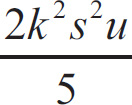

(D) 
![]()
(E) 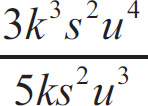

22. If the dots shown below are connected by starting at J and then going to K, for which answer choice is it necessary to retrace a line or lift the pencil in order to draw it?


(A) 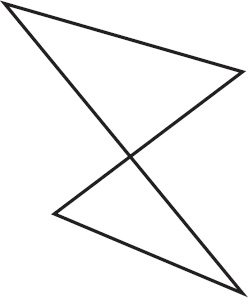

(B) 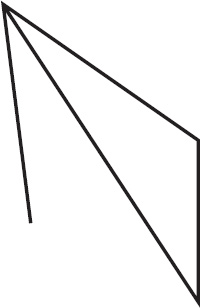

(C) 

(D) 

(E) 

23. The average of five consecutive even integers is 12. What is the greatest of these integers?
(A) 8
(B) 10
(C) 13
(D) 14
(E) 16
24. If p + q is divisible by 13, which of the following is also divisible by 13?
(A) (p × 3) + (q × 3)
(B) 
![]()
(C) (p × 13) + q
(D) p + (q × 13)
(E) (p × q) – 13
25. What could be the sum of M, N, P, and Q if each letter represents a different digit?
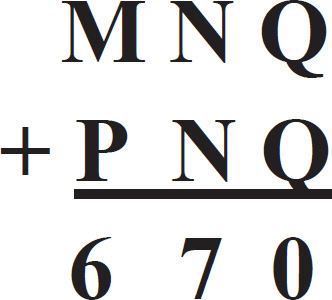

(A) 18
(B) 17
(C) 16
(D) 13
(E) 10
STOP
IF YOU FINISH BEFORE TIME IS CALLED,
YOU MAY CHECK YOUR WORK ON THIS SECTION ONLY.
DO NOT TURN TO ANY OTHER SECTION IN THE TEST.